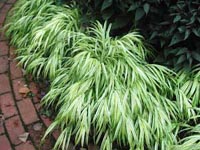Resource Library
Plant of the Week: Japanese Forest Grass
The University of Arkansas System Division of Agriculture does not promote, support or recommend plants featured in "Plant of the Week." Please consult your local Extension office for plants suitable for your region.
Japanese Forest Grass
Latin: Hakonechloa macra 'Aureola'

The sudden appearance of a stunning new plant in the garden is occasion for much excitement amongst gardeners, especially if it is uniquely beautiful, long-lived and well behaved. Japanese forest grass (Hakonechloa macra 'Aureola') is just such a plant, and it deserves a closer look.
Hakonechloa is a deciduous grass that grows 12 to 16 inches tall with a spread of a couple feet. The slender stems support gracefully arching leaves that are to a half-inch wide and splays out in graceful mound, layering leaves atop one another in a kind of living cascade. The plant produces rhizomes and the crown slowly - very slowly - expands its place in the garden.
The most commonly offered Hakonechloa is the cultivar ‘Aureola’ with golden-chartreuse leaves and a narrow band of green down the center. ‘All Gold’ is a newer selection with all golden foliage. ‘Albostriata’ has a gray-green appearance with a white variegation down the leaf. The green, non-variegated form does not seem to be offered in the nursery trade at the current time.
Hakonechloa presented itself to me about 1995. The common name, Japanese Forest Grass, is descriptive for the species and indicates that this species is a woodland grass in its native habit. In Japan, it grows on the mountainside cliffs of Mount Hakone, a resort area on Japan’s main island near Yokohama with a splendid view of Mt. Fuji. The Latin name is given by the mountain and, presumably, with a reference to green (chloro) tacked on for good measure. It’s monotypic with only one species known.
Hakonechloa was introduced into American gardens by Harold Epstein (1903-1997), a New York City gardener and plant collector. On the introduction of Hakonechloa, Epstein is reported to have said: "That’s here by accident, like a stowaway. When I import plants from Japan, they are shipped with bare roots wrapped in sphagnum moss. This grass was an unknown seedling hidden in one of those mossy covers."
While that story remains the official record, the explanation seems a bit beyond the realms of believability to me.
Epstein was a consummate traveler, making it around the world at least four times. But Japan was his favorite destination. He made at least 29 trips to the island nation. Because of the many trips, his acre and a half garden in Larchmont, N.Y., had one of the most complete collections of Japanese garden plants found anywhere in the world.
An accountant by profession, Epstein became serious about gardening - especially rock gardening - in the 1930's. He served as president of the American Rock Garden Society for 16 years and was a co-founder of the American Hosta Society, but Epstein also received awards for his works with rhododendrons, orchids and other garden societies.
Keeping Hakonechloa alive is not especially hard, but getting it to grow is a bit more demanding. Unlike most grasses, this one is slow growing. It’s growing successfully at the Fayetteville Square garden under the care of Susan Regan. They are located in moderate shade in a rich, well-amended soil that’s top-dressed with a liberal dollop of composted horse manure each spring.
Hakonechloa is sensitive to drought, so plants should never be allowed to become too dry. But, because its natural habitat is on a cool, moisture shrouded cliffside in Japan, it’s sensitive to poor drainage. If you have the right kind of site, the clump will slowly increase in diameter and can be divided just before new growth begins in the spring. I have found the white-variegated form easier and faster growing than the golden form, but it’s not nearly as striking in the landscape.
By: Gerald Klingaman, retired
Extension Horticulturist - Ornamentals
Extension News - March 18, 2005
The University of Arkansas System Division of Agriculture does not maintain lists of retail outlets where these plants can be purchased. Please check your local nursery or other retail outlets to ask about the availability of these plants for your growing area.